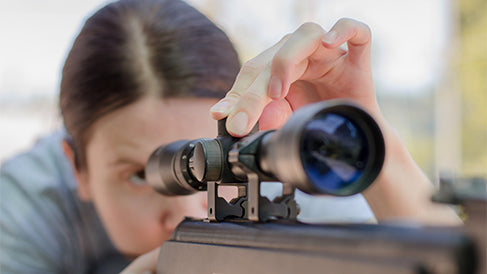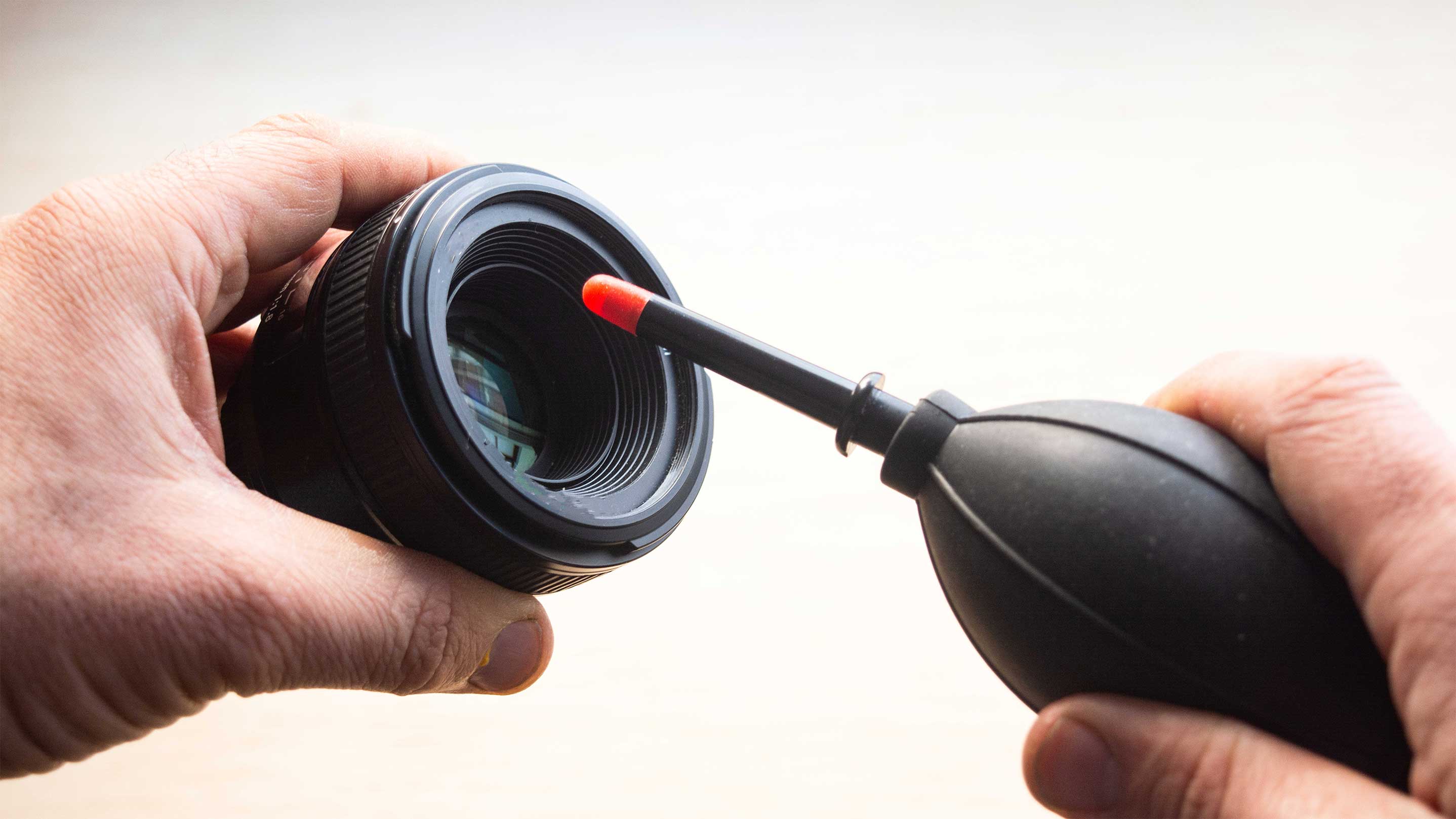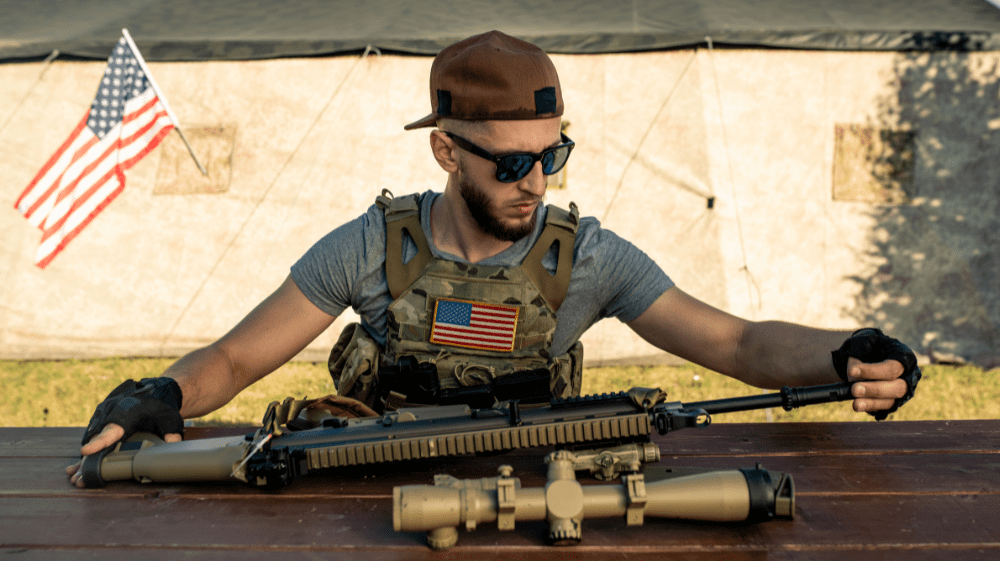The article aims to equip readers, whether novice or experienced shooters, with the knowledge and skills necessary to accurately adjust and zero their rifle scopes, enhancing shooting precision and safety.
Whether you're a novice or simply refreshing your knowledge on firearm procedures, mastering the art of zeroing your optic to your rifle is essential. Adjusting the scope on a rifle is an important step in ensuring accurate shots.
Remember to prioritize safety by adhering to the fundamental rules of firearm safety at all times.
(Reading Time: 5-7 Minutes)
Aligning a scope is a crucial step in ensuring the accuracy of your rifle. This process involves tuning the optic to synchronize your point of aim (POA) with your point of impact (POI) at a specific distance. By doing so, you can reliably hit your target at known distances.
Here are the steps to adjust the scope:
1. Mount the Scope
While sighting in a rifle may not be excessively complex, the precision of your firearm and scope combination ultimately hinges on the quality of your scope installation onto the mount and attachment to the rifle. It is highly advisable to ensure a meticulous mounting process for your optic.
In addition to the mounting procedure, opting for a substandard optic can result in an inaccurate rifle setup, especially if frequent adjustments to the turrets for elevation and windage are necessary.
Before adjusting the scope, make sure it is properly mounted on the rifle. A quality mount job is essential for accuracy. For reassurance regarding the correct installation of your scope, refer to our comprehensive guide on How to Mount a Rifle scope.
2. Zeroing
Elevation Adjustment Example for MOA Scope:
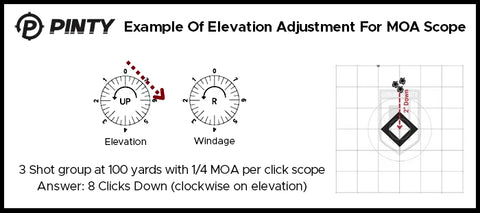
Zeroing is the process of aligning the point of aim (reticle) with the point of impact (bullet) at a specific distance. It is necessary to zero a new scope or when shooting at different distances from the zeroed distance.
If you observe the reticle moving downwards while adjusting "up" on the elevation turret, remain calm; your scope is not malfunctioning. When adjusting "up," the reticle moves downward inside the scope, necessitating you to raise the rifle to realign the reticle with the target. This adjustment, altering the rifle's orientation, results in a higher bullet impact.
Tip: If your scope features exposed turrets, you should be able to adjust elevation while maintaining your position and looking through the scope. To aid in remembering the correct adjustment direction, envision the turret as a screw. Turning the screw "up" involves counter-clockwise rotation to raise the reticle, while turning it "down" requires clockwise rotation to lower the reticle. If your turrets are capped, ensure to replace the caps after adjustments.
Windage Adjustments (Shifting Bullet Impact Left or Right)
Similar to elevation adjustments, windage adjustments play a crucial role in zeroing a scope or compensating for shooting conditions. While elevation turrets govern changes in the vertical plane, windage turrets facilitate adjustments for left or right bullet impact.
Windage Adjustment Example for a Scope:
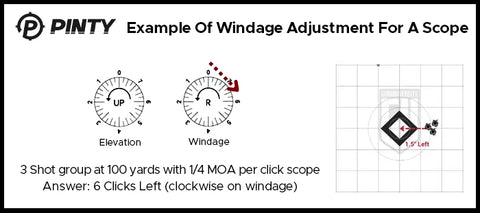
Typically, once I've zeroed my scope, I tend to leave the windage turrets untouched. While wind can significantly affect a bullet's trajectory, especially over long distances, I find it more practical to compensate by "holding" left or right, essentially aiming off-center from the target (particularly useful with reference marks on the reticle).
This approach saves time compared to readjusting the windage turret for every change in wind direction, which can be rapid and unpredictable. Additionally, there's the risk of forgetting to return the windage turret to its zero position.
Pro Tip: To adjust the elevation (up and down) of the bullet impact, use the scopes elevation turret. Turning the turret up will raise the bullets impact, while turning it down will lower it. While elevation turrets handle vertical adjustments, windage turrets control horizontal adjustments for left or right impact.
3. Parallax Adjustment
Some scopes have a parallax adjustment feature. Parallax occurs when the reticle appears to move in relation to the target when the shooter's head or eyes are moved.When your rifle scope is misaligned, it can introduce a phenomenon known as parallax. To grasp the concept of parallax:
Extend your left arm forward with your index finger raised. Repeat the action with your right arm and hand, aligning it somewhere between your extended left hand and your eyes. You'll notice two fingers, aligned but at different distances.
Now, while keeping your fingers steady, move your head from side to side. Notice how your fingers appear to shift positions? That's parallax in action.
Parallax adjustment serves the crucial purpose of ensuring that your rifle scope's reticle aligns with your target image on the same focal plane. Without this adjustment, you may experience unwanted movement or crosshair displacement when shifting your head and eyes to different positions. Such discrepancies can lead to eye strain, inaccurate shots, and confusion for novice shooters. It's important to note that parallax adjustment is relevant only for rifle scopes.
On the other hand, Red dot sights are "parallax free" devices, maintaining consistency in aiming regardless of the viewing distance. Adjusting the parallax helps ensure that the reticle and the target image are on the same focal plane, reducing eye strain and improving accuracy.
4. Focus Adjustment
Parallax is an undesirable effect for any shooter, often resulting in missed targets and frustration at the range. To rectify this, adjust the target focus using the following steps:
Parallax is typically caused by changes in the orientation of the rifle barrel, leading to shifts in the bullet's trajectory. Begin by focusing on the reticle, then adjust the target focus. Move the scope's focal point of the image until it aligns perfectly with the reticle. When both the reticle and the target's image are in focus along the same plane, it signifies the absence of parallax effects.
The focus adjustment is used to focus the reticle crosshairs to your eye. It can be a separate adjustment or part of the ocular focus adjustment. Adjusting the focus ensures a clear and sharp reticle image.
It's important not to confuse the terms "adjustable objective" and "adjustable parallax," as they refer to different aspects. While an "adjustable parallax" is desirable in a scope, having an "adjustable objective" on an adjustable parallax scope is not ideal. Instead, look for a side-focus or side-parallax knob. When selecting a scope, take care not to confuse these features.
In conclusion, mastering the art of adjusting and zeroing your rifle scope is essential for achieving accuracy and consistency in your shooting endeavors. By following the steps outlined in this guide and prioritizing safety at all times, you can confidently fine-tune your optic to synchronize your point of aim with your point of impact, ensuring reliable performance in various shooting conditions. Whether you're a novice or a seasoned marksman, investing time and effort into understanding and practicing these techniques will undoubtedly elevate your shooting skills to new heights. Happy shooting, and always remember to prioritize safety first.
Call to Action
Are you ready to revolutionize your sighting experience? Visit our product page now to discover how the Pinty Laser Bore Sighter can elevate your shooting accuracy to new heights.




